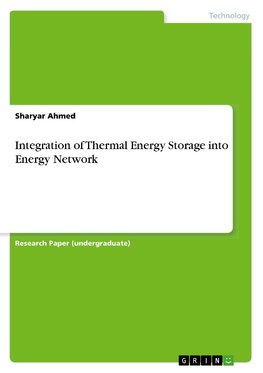
-
 Anglický jazyk
Anglický jazyk
Integration of Thermal Energy Storage into Energy Network
Autor: Sharyar Ahmed
Research Paper (undergraduate) from the year 2017 in the subject Engineering - Chemical Engineering, grade: 65.00, University of Birmingham (University of Birmingham), course: Chemical Engineering, language: English, abstract: Fossil fuel plays a major role... Viac o knihe
Na objednávku
16.65 €
bežná cena: 18.50 €
O knihe
Research Paper (undergraduate) from the year 2017 in the subject Engineering - Chemical Engineering, grade: 65.00, University of Birmingham (University of Birmingham), course: Chemical Engineering, language: English, abstract: Fossil fuel plays a major role in the society, and they are commonly used for the heat and power production for the commercial and residential applications. According to UKERC Research Report, heat accounts for around 47% of the total energy consumption in the UK and 33% of carbon emissions. Approximately, 80% of this heat account for space and water heating. At the same time, a significant amount of heat is being used by the industry sector 24%, for industrial processes. The corporation of thermal energy storage system is very beneficial for CO2 emission reduction and energy saving. And, it is the key technology to balancing the energy system stable with the increasing capacity from wind.
This research report uses the concept of Wind-Powered Thermal Energy System (WTES) recently proposed by (2015, Okazaki et al) with Latent-Thermal Energy Storage (TES) design to produce stable heat for industrial application and also, looked at the economics of h-WTES (Direct heat production) and electrical-WTES (Indirect heat Production using electrical heater) with thermal energy storage for heat generation and compared the results with the traditional gas boiler.
This paper demonstrates the potential and probable costs of different WTES with thermal energy storage and a design of tube-in-tank phase change thermal storage system by using a previously developed an effectiveness-NTU method potentially applicable for the industrial sector.
From the results, it was identified that it is more economically feasible to generate heat from h-WTES (Direct heat production) with thermal storage than e-WTES (indirect heat production). 56.2 £/MWh-t and 63.36 £/MWh-t, the levelized cost of heat for h-WTES and e-WTES respectively. Also, the result suggested that the renewable technologies with TES present the most expensive LCOE for heat production compared to the industrial gas boiler which has the LCOE of 15-20 £/MWh.
The result from the second part of the research shows that the technique effectiveness-NTU can accurately predict the average effectiveness of the system (performance) with high heat transfer rate for discharging and charging processes (115kW). Therefore, the design can effectively be integrated into WTES to provide a significant amount of heat demand for industrial applications. It was also, found that latent-TES can hold up to 6.5 times more heat than sensible-TES.
- Vydavateľstvo: GRIN Verlag
- Rok vydania: 2018
- Formát: Paperback
- Rozmer: 210 x 148 mm
- Jazyk: Anglický jazyk
- ISBN: 9783668603448











 Nemecký jazyk
Nemecký jazyk 